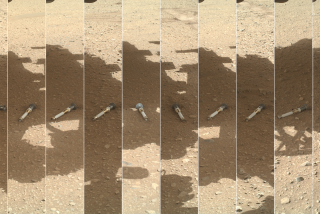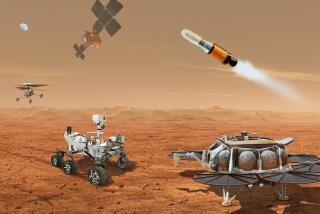Mars Probe Lost Due to Simple Math Error
NASA lost its $125-million Mars Climate Orbiter because spacecraft engineers failed to convert from English to metric measurements when exchanging vital data before the craft was launched, space agency officials said Thursday.
A navigation team at the Jet Propulsion Laboratory used the metric system of millimeters and meters in its calculations, while Lockheed Martin Astronautics in Denver, which designed and built the spacecraft, provided crucial acceleration data in the English system of inches, feet and pounds.
As a result, JPL engineers mistook acceleration readings measured in English units of pound-seconds for a metric measure of force called newton-seconds.
In a sense, the spacecraft was lost in translation.
“That is so dumb,” said John Logsdon, director of George Washington University’s space policy institute. “There seems to have emerged over the past couple of years a systematic problem in the space community of insufficient attention to detail.”
The loss of the Mars probe was the latest in a series of major spaceflight failures this year that destroyed billions of dollars worth of research, military and communications satellites or left them spinning in useless orbits. Earlier this month, an independent national security review concluded that many of those failures stemmed from an overemphasis on cost cutting, mismanagement, and poor quality control at Lockheed Martin, which manufactured several of the malfunctioning rockets.
But NASA officials and Lockheed executives said it was too soon to apportion blame for the most recent mishap. Accident review panels convened by JPL and NASA are still investigating why no one detected the error.
“It was launched that way,” said Noel Hinners, vice president for flight systems at Lockheed Martin’s space systems group. “We were transmitting English units and they were expecting metric units. The normal thing is to use metric and to specify that.”
None of JPL’s rigorous quality control procedures caught the error in the nine months it took the spacecraft to make its 461-million-mile flight to Mars. Over the course of the journey, the miscalculations were enough to throw the spacecraft so far off track that it flew too deeply into the Martian atmosphere and was destroyed when it entered its initial orbit around Mars last week.
John Pike, space policy director at the Federation of American Scientists, said that it was embarrassing to lose a spacecraft to such a simple math error. “It is very difficult for me to imagine how such a fundamental, basic discrepancy could have remained in the system for so long,” he said.
“I can’t think of another example of this kind of large loss due to English-versus-metric confusion,” Pike said. “It is going to be the cautionary tale until the end of time.”
At the Jet Propulsion Lab, which owes its international reputation to the unerring accuracy it has displayed in guiding spacecraft across the shoals of space, officials did not flinch from acknowledging their role in the mistake.
“We know this error is the cause,” said Thomas R. Gavin, deputy director of JPL’s space and earth science directorate, which is responsible for the JPL Mars program. “And our failure to detect it in the mission caused the unfortunate loss of Mars Climate Orbiter.
“When it was introduced and how it was introduced we don’t know yet,” Gavin said.
NASA officials in Washington were reluctant to blame either Lockheed Martin or JPL solely for the problem, saying that the error arose from a broader quality control failure.
“People make mistakes all the time,” said Carl Pilcher, the agency’s science director for solar system exploration. “I think the problem was that our systems designed to recognize and correct human error failed us.
“We don’t see any connection between this failure and anything else going on at Lockheed Martin,” Pilcher said. “This was not a failure of Lockheed Martin. It was systematic failure to recognize and correct an error that should have been caught.”
In any event, scientists are anxious that the conversion error does not affect a second spacecraft, the Mars Polar Lander, now approaching the red planet for a landing Dec. 3. The lost orbiter would have served as a radio relay for the lander before beginning its own two-year survey of the Martian atmosphere and seasonal weather.
Data exchanges for the Global Surveyor, which has been orbiting Mars since 1997, have been conducted exclusively in the metric system, Hinners said. Mission controllers expect to use the Surveyor as a relay station in place of the lost orbiter.
If found formally at fault by an accident review board, Lockheed will face financial penalties. But it was not certain Thursday whether Lockheed’s contract with JPL actually specified the system of measurements to be used, as many aerospace agreements now often do.
Whatever the contractual consequences for the aerospace company, the loss of the Mars orbiter might have a lasting effect on public confidence in NASA, space analysts said.
Earlier this year, for example, NASA faced public concerns about its Cassini probe as it swung within a celestial hairsbreadth of Earth with an on-board cache of plutonium. The agency’s matchless skill in navigating space helped defuse fears of a potentially lethal collision between Earth and the Cassini probe.
Now that skill will be more open to question, analysts said Thursday.
“It is ironic,” Logsdon said, “that we can cooperate in space with the Russians and the Japanese and the French but we have trouble cooperating across parts of the United States. Fundamentally, you have partners in this enterprise speaking different languages.”
More to Read
Sign up for Essential California
The most important California stories and recommendations in your inbox every morning.
You may occasionally receive promotional content from the Los Angeles Times.










